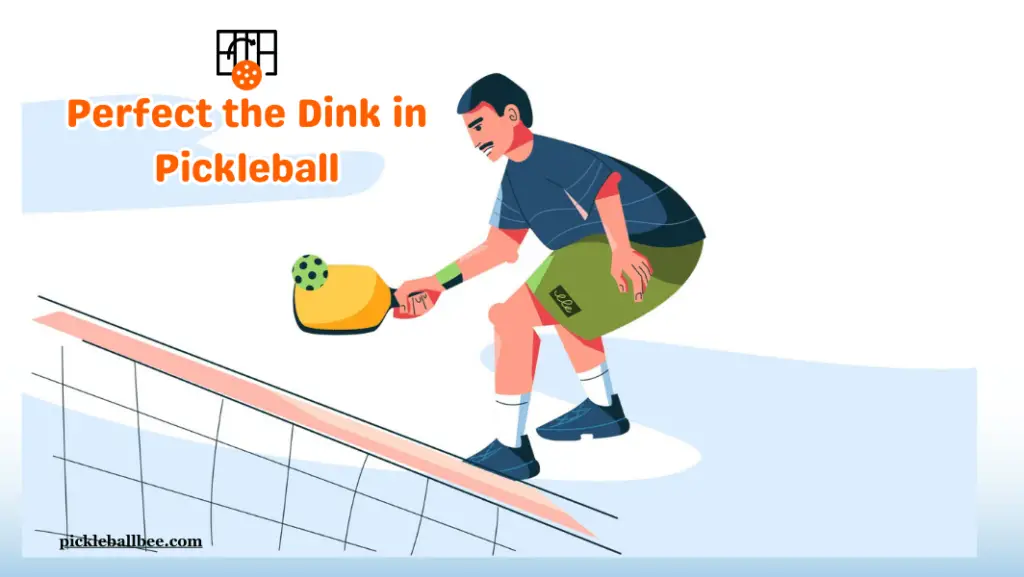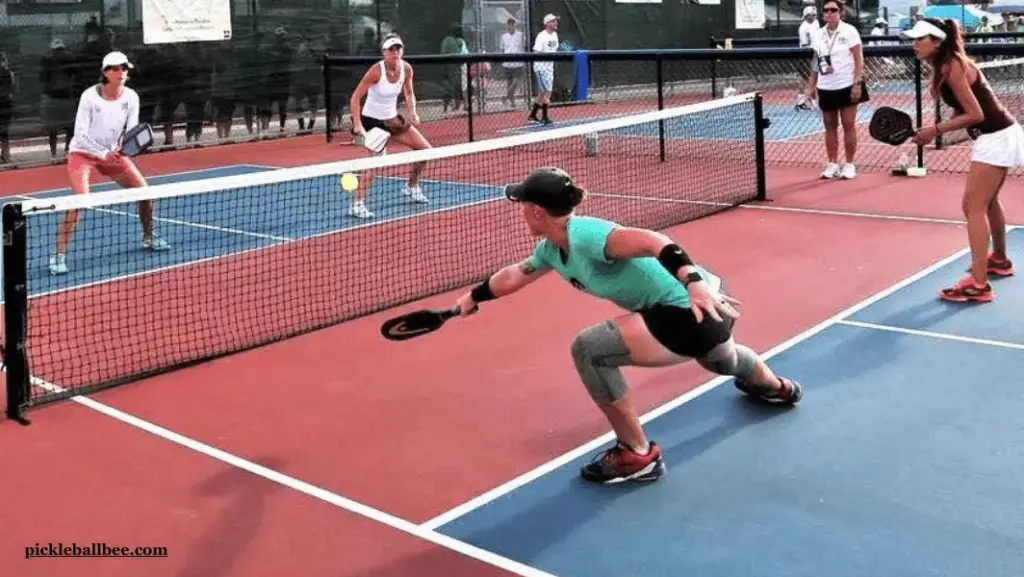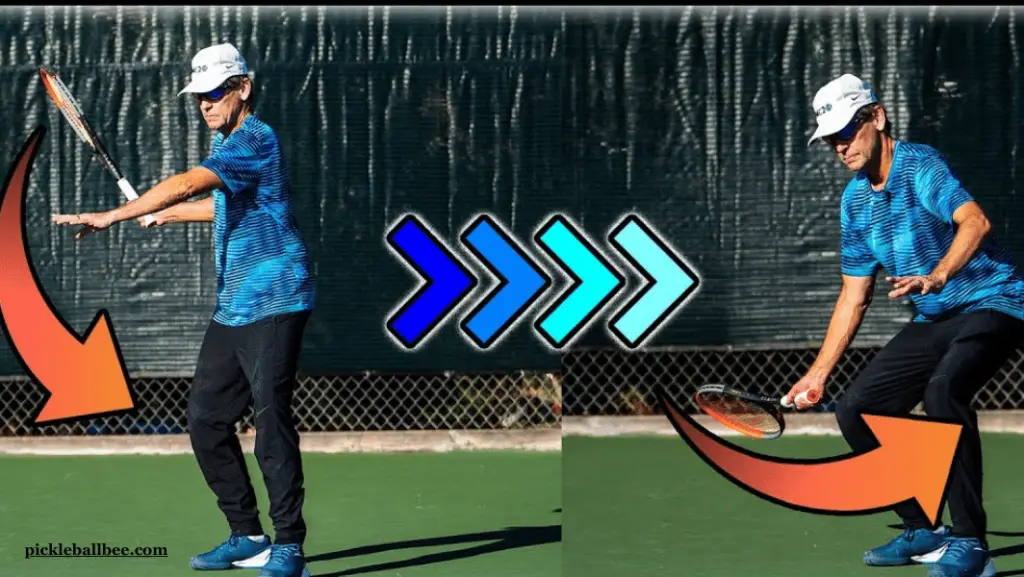In pickleball, dinking represents a nuanced skill that players often love and hate. Moving past the beginner stages, you’ve likely found yourself participating in this aspect of the game, trying different strategies to make it work in your favor. Yet, sometimes, despite our best efforts, we find ourselves puzzled, asking, “Why did my dink come back so fast?” or questioning the point of dink in pickleball if the opponent will simply bang it right back. These common questions are ones that many players wrestle with, and here, I aim to answer and define the strategic element of dinking in pickleball, leveraging personal insights and a deep understanding of the game’s dynamics.

Table of Contents
What is Dinking?
In pickleball, dinking is more than just a shot; it’s a tactical move designed to render your opponent’s return unattackable, keeping the ball low to force an error as it either hits the net or goes out. The focus here isn’t just on avoiding errors or adopting a purely defensive stance; it’s about a strategic mindset that steers clear of common mistakes many players make. For the vast majority of the time, the strategy and tactics behind a well-placed dink are about setting up an offensive opportunity in the future, much like investing money to gain compound interest over time.
This approach requires hard work and patience in the moment to reap the benefits later, leading us to the crucial question: how do you master this skill to consistently outmanoeuvre your opponents?
The key element to understand here is that dinking is not just about hitting the ball back and forth; it’s about creating opportunities and applying pressure, much like a chess game. Each dink should be considered an investment, where you put in effort and strategic thinking to eventually get a significant advantage at a crucial date in the match. The real challenge lies in the execution and the ability to maintain this level of play, which is why dinking is often seen as a blend of art and science in the pickleball world.
What Is A Dink Shot In Pickleball?

A dink shot in pickleball is a soft shot executed either on the bounce or directly from the air, known as a dink volley, strategically placed in or near the Non-Volley Zone (NVZ), compelling the opposing team to make a challenging low contact. This area, colloquially termed the Kitchen, spans 7 feet deep and 40 feet across, starting from the NVZ line to the net.
The essence of a dink lies in its subtlety and finesse, aiming not just to return the ball but to tactically position it where it becomes arduous for the opponents to launch an attacking return. The goal is to maintain the ball low post-bounce, thereby forcing the opponents into awkward, low contact points, which could lead to defensive mistakes and, ultimately, gain points.
Mastering the dink requires a blend of strategy and precision, making it a pivotal aspect of advanced pickleball play. Unlike aggressive shots aimed at overpowering the opponent, the dink is about control and placement, pushing the opponent into uncomfortable positions, like stretching or jammed contacts, which increases the chances of errors. The main purpose of dinking is not just defensive; it’s a calculated offensive maneuver that sets the stage for more assertive plays. By keeping the ball low and close to the net, players can effectively dictate the pace of the game, winning points through strategic finesse rather than sheer power.
The art of dinking embodies the essence of pickleball, where subtlety, strategy, and patience converge to create opportunities. As players engage in this delicate push and pull, they not only challenge their opponents but also refine their own skills, finding balance between aggression and restraint. Whether it’s drawing the opponent off-balance or setting up for a decisive shot, the dink shot is a testament to the tactical depth that makes pickleball an engaging and rewarding sport.
what is Dead Dink in pickleball
A dead dink in pickleball is a shot that lacks both spin and pace, causing it to sit up in the middle of the kitchen, making it easier for opponents to speed up the return. While attempting a dead dink might seem like a strategy, it’s often considered a risky move because it becomes attackable, especially by skilled players. If executed improperly, a dead dink can leave you vulnerable to aggressive shots aimed right at your elbow (for right-handed players) or allow your opponent to take the offensive, employing forehand rolls, backhand rolls, or even hard swings.
Despite these risks, some players, like Riley Newman, use dead dinks as a tactical counter-punch, deliberately hitting them to tempt opponents into speeding up the ball, thus creating opportunities for counter-attacks. However, this approach requires precise control and a deep understanding of your and your opponent’s abilities on the court.
Mastering the Dink: A Strategic Move in Pickleball
Contrary to common belief, a dink is not just a defensive or neutralizing shot; it embodies a strategic mindset that requires players to wait patiently for the right opportunity to attack. This misconception has led many to underestimate the dink’s potential as an offensive tool designed to set up pressure on the opposing team. By forcing an opponent to pop-up the ball, it creates an opportunity to put away a point decisively. Particularly in a defensive position, when opponents are drilling hard shots, a well-executed dink can help regain control of the dink battle, turning the tide of the game.
This nuanced shot, when used correctly, becomes an effective weapon in pickleball, capable of significantly improving your game. Learning how to successfully deploy a dink is indeed a great place to start for anyone looking to enhance their strategic play. It’s about understanding that the dink is much more than a mere return; it’s a calculated move that, when integrated into your gameplay thoughtfully, can open up a multitude of offensive opportunities and elevate your overall performance on the court.
What is the First rule of Dinking in pickleball?
The primary objective of dinking in pickleball is to force opponents into making low contact points, making it a stand alone objective that applies pressure and can be accomplished in the majority of dinks. Even when pressed, the main goal remains to prevent being attacked on the next shot, employing an aggressive dinking strategy to make it difficult for opponents to launch a counter-attack, while setting yourself up for future plays. This delicate balance between objectives, whether playing aggressive or defensive, dictates the success of each dink, aiming to place the ball with an acceptable net clearance range, ensuring it travels deep into the opponent’s NVZ or falls short within the kitchen, thus controlling the game’s pace and space.
Understanding the range and trajectory required for effective dinks, whether opting for a deeper, more aggressive shot that passes closer to the net by about a foot or a softer approach aimed at the general vicinity of the kitchen’s higher end, is crucial. This strategic play not only challenges the opponents but also enhances one’s mastery over the game, highlighting the nuanced depth of pickleball where precision, strategy, and control converge to define the art of dinking.
Crushing Opponents with Dink and Drop Shots
A common mistake among pickleball players is to confuse the terms drop and drop shot with dinking, although both are soft shots with distinct purposes. The difference lies in their application and strategic intent within game situations. A drop shot is typically hit off the bounce from the baseline or transition zone (the back half of the court towards the backcourt), aiming to arc gently over the net into the NVZ (Non-Volley Zone), compelling the other team to sprint forward to retrieve it, potentially resulting in a winner if they fail to reach it.
Conversely, a dink is executed closer to the net, within the kitchen, to prevent the opponent from making an aggressive shot back, thus setting up an attacking opportunity for your team.
People often question the difference between a dink and a drop because both are soft shots aimed to reduce the opponent’s attackability. However, the primary objective of a drop is to advance towards the net without being attacked, while a dink is employed when players are already at the NVZ, using precision to keep the play close and controlled, often to reset the point. Mastering when and how to use each shot can significantly enhance strategic play in pickleball, making dinking and dropping essential skills for navigating the subtle complexities of the game.
ALSO READ: What Is A Bert In Pickleball?
Precision in Dink Shot Placement
In the strategic world of dinking, the purpose and intention behind each shot are crucial, with players aiming to vary their shots to move and keep opponents guessing. Effective dinking involves hitting the ball with not just any regular, repetitive motion but with deliberate purpose to avoid producing dead balls that serve no purpose. The art lies in changing the habit of predictable play and incorporating varied shots, including topspin or slice, to complicate the opponents’ response.
Important to this strategy is footwork; maintaining agile feet and being ready to hit with a small split step when time allows are essential components. Dinking should target general, lateral areas of the court such as cross-court, middle, and down the line to maximize effectiveness.
The choice of lateral targets should vary between hitting deeper into the kitchen or shorter to maintain pressure. In a typical dink battle, where all four players are engaged at the NVZ line, the intention behind each dink can either jam up or stretch the opponents, ideally resulting in a shot that’s accidentally hit higher than intended, which you can then capitalize on to initiate an attack. This nuanced approach of varying targets and depths transforms the dink from a mere return into a strategic weapon, laying the groundwork for offensive plays and asserting control over the game’s pace.
Perfecting the Pickleball Dink: A Step-by-Step Guide
Perfecting the Pickleball Dink: A Comprehensive Guide to Mastering the Art of Precision Shots. Learn the Essentials Before You Dive into the 11 Key Steps.
Step 1: Perfect Your Stance

Begin with a solid athletic stance: knees bent, feet at shoulder width. This compressed position not only mirrors the readiness seen in sports like football and baseball but also sets you up to react swiftly and effectively in the dynamic environment of the pickleball court.
Step 2: Paddle Preparation
Hold your pickleball paddle out in front of your body, maintaining a loose grip to enhance both feel and control. This posture is crucial for achieving consistency in your shots, ensuring you’re always in the best position to make effective contact with the ball.
Step 3: Eye on the Ball
Constantly watch the ball to avoid mishits. Keeping your eyes locked on the pickleball until the moment it meets your paddle is essential for timing your dink shots with precision, allowing for greater control over the play.
Step 4: Masterful Movement
Move Your Feet actively across the pickleball court, especially when dinking near the Kitchen line. Utilize lateral steps to maintain an optimal body alignment parallel to the net, ensuring you’re always in the ready position to execute your next strike.
Step 5: Strategic Positioning
Hold the Line at the Non-Volley Zone to apply pressure on your opponents and minimize giving them easy targets or additional court space to exploit. This tactic is about controlling the space and pace of the game, making it harder for opponents to find angles for a successful shot.
Step 6: Safeguard Your Feet
To Protect Your Feet, extend your paddle forward, keeping it between you and the oncoming ball. This proactive stance helps in defending against low dinks that are difficult to react to, ensuring you maintain balance and readiness for the next play.
Step 7: Under and Up
When striking a dink, aim to get the paddle under the ball. This technique, performed from a compressed, ready position, allows for a gentle lift that is crucial for clearing the net while keeping the shot unattackable.
Step 8: The Gentle Lift
Execute a Gently Lift through the ball using a controlled motion from your shoulder, avoiding any sharp jerks or wrist snaps. This smooth action ensures the dink remains unattackable, flying low over the net to land softly in the opponent’s court.
Step 9: Net Clearance
Respect the Net by ensuring your dink’s apex has a safe margin of error over the net. This approach reduces the risk of hitting the dink too low and losing the point by a net fault.
Step 10: Stay Compressed
Throughout the contact with the ball, Stay Low to maintain balance and control. This compressed stance keeps your paddle at an optimal height, making your shots less attackable and more strategic.
Step 11: Ready Position Reset
After completing your dink, immediately Revert to Ready, preparing for any return shot your opponents might send back, be it a surprise fastball or a lob. This readiness is key to maintaining the flow and control of the game, allowing you to adapt and respond to the evolving dynamics of the match.
If you’re looking for more pickleball tips and strategies, be sure to explore our resources on “Pickleball Singles Strategies,” “Pickleball Doubles Strategies,” and “Pickleball Rules for Success.” These guides will further enhance your pickleball knowledge and skills.
FAQs:
What is a dink court?
A dink court in pickleball refers to the area near the net, often known as the Non-Volley Zone (NVZ) or kitchen. It’s the region within seven feet from the net where players are not allowed to volley the ball. Dinking, which involves soft, controlled shots, is commonly used in this court to set up strategic plays. Mastering the dink court is crucial for maintaining control, reducing errors, and setting up winning shots in pickleball games.
What is kitchen in pickleball?
In pickleball, the “kitchen” refers to the Non-Volley Zone (NVZ), a seven-foot area adjacent to the net on both sides of the court. Players are not allowed to volley the ball while standing inside this zone. The kitchen is a critical area where dinking, soft shots, and strategic play are essential. Understanding and effectively utilizing the kitchen is fundamental for success in pickleball, as it helps control the game and create winning opportunities.


